The pioneers taught us much about what we know when it comes to campfire cooking and cast iron cookware. They cooked almost every meal in these types of skillets and Dutch ovens.
It was also very important that they cared for these items because Walmart was not a short car drive away. Amazon did not deliver to the homestead in the 1800s.
It is not uncommon to find some old cast iron cookware in yard sales or flea markets, but most of the time it is rusted or crusted with the use and storage. Some pieces of cast iron cookware can be very disheveled looking, and you might wonder who would ever buy something so beat up?
Well, if you know how to restore cast iron cookware you can wind up with an entire inventory of high-quality, durable, cookware that was nearly someone else’s trash!
Benefits of Cast Iron Cookware
Modern cookware is pretty bad. It’s cheaply made, like most things, and you can get about 3 years out of it, at best! Cast iron is incredibly durable and is made to take a beating both physically and from the heat of an open fire.
Cast iron is also much safer to cook on because modern cookware is designed to assure that foods don’t stick rather than other factors.
So, chemicals like Teflon and other cheap metals are used to create the pans that you feed your family with each day.
You will also absorb some of that iron from cooking in the cast iron pan which can be great for your overall health.
Restoring Cast Iron Cookware
There are several steps in restoring cast iron cookware. Depending on how bad off it is, you might be able to skip some steps or spend less time on them. I have seen varying degrees of cast iron cookware. Some are so rusted and crusted with debris that it’s hard to tell what they should look like?
Others are just a little rusted and that can be worked off pretty easily. Let’s look at the steps:
Assess
Before you begin anything, you are going to want to assess the condition of your piece before you begin step one. This will be a time to decide what tools you might need. At the very least I would have the following tools for this job.
- Wire Brush or Dremel
- Towel
- Oil
- Coarse Sea Salt
Cleaning Debris
#1. This is likely to be your most involved step. The worse off the piece the more weapons I bring to the fight. If I am going to restore multiple pieces of cast iron cookware that are in pretty bad shape, I will first place them in the oven and run them on a full oven cleaning cycle.
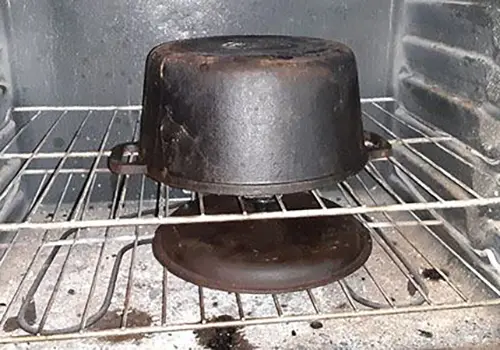
Never hurts to run the old oven cleaning cycle, right! Your oven probably needs it anyway.
After the cycle is complete, I will let the cookware cool down before starting to get at it with elbow grease. If there are still thick layers of stuck-on debris and rust, you may need to employ the help of a Dremel or a wire brush. You could also use a wooden spatula to knock off a good amount of the buildup.
If you are dealing with light rust, then you can simply pour some salt and oil into the ban and scour it with a dry rag.
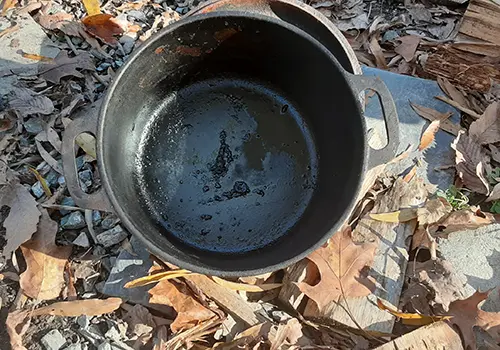
In fact, if you had no power or no access to power tools you would eventually wear anything down with this method, as long as the cookware is warm.
Warm Salt and Oil
#2. Once I am through with the initial debris removal, I like to move to another round of oil and coarse sea salt. This time I am going to look to “polish” the edges and really get this cast iron looking good. Some people say they use sandpaper, but I just count on the salt.
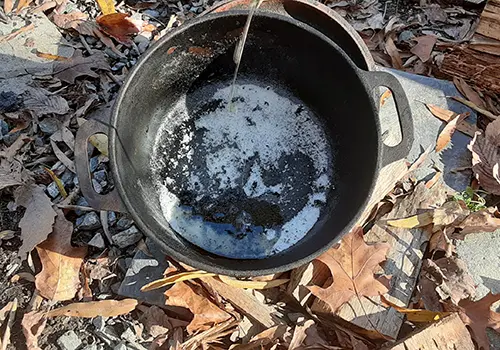
Be sure the pan, salt, and oil are warm, and it will make all the difference. Work the inside of the pan the edges, the bottom, and the sides. They all need love.
Seasoning
#3. Wipe the pan out with a dry rag and remove all the salt.
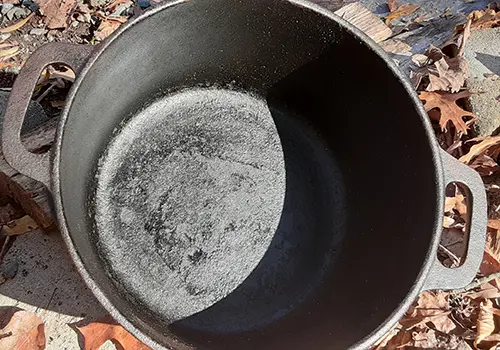
You are now going to reseason your pan. After all this work the pan needs a good seasoning. Preheat the oven to 450 degrees.
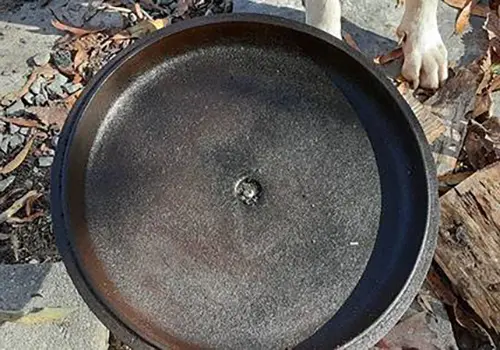
Using corn or vegetable oil you simply coat the entire piece of cookware in oil. Both sides. Buff it a bit with a dry rag as you do not want the oil dripping off the cast iron and onto the bottom of the oven or that will start a fire.
Place a sheet pan on the lower rack of your oven and place the pan, mouth side down, and bake it for 30 minutes. Repeat this process a few times until the pan has taken in all that good oil.
Storing and Use
#4. The most important part of this process is to use the pan regularly. It’s easy to spend all that time and effort on making the pan look good and store it in a drawer till it looks rusty again. The key to storing cast iron properly is to not store it too long! This is high-quality cookware that you should use each day or at least each week.

The more you use it the better seasoned it becomes.
If I know I am going to store a piece for a long time, like my cast iron wok. I will just reoil before long storage. We don’t always break out the wok here so it can go away for a month or so at a time. The coating of fresh oil keeps the rust at bay and also keeps the pan seasoned.
There is really no substitute for the durability and capability of cast iron cookware. Teflon-coated pans are dangerous and often thin-bottomed which is just a nightmare in the kitchen. Expensive cookware is beautiful and polished but would be ruined over an open flame.
Cast iron cookware can get the job done over a conventional range or a campfire. It really doesn’t matter. For preppers, survivalists, and campers there is no better set to have on hand.
You can often save lots of money if you know how to restore cast iron cookware. Flea markets and yard sales are full of pieces that people have long given up on and assume are little more than fodder for a few bucks or could be used as decorative pieces at best.
This article first appeared on Ask A Prepper.
You may also like:
Makin’ Bacon: How to Dry Cure Pork Belly
An Insanely Effective Way to Build a 5 Year Food Stockpile (Video)








